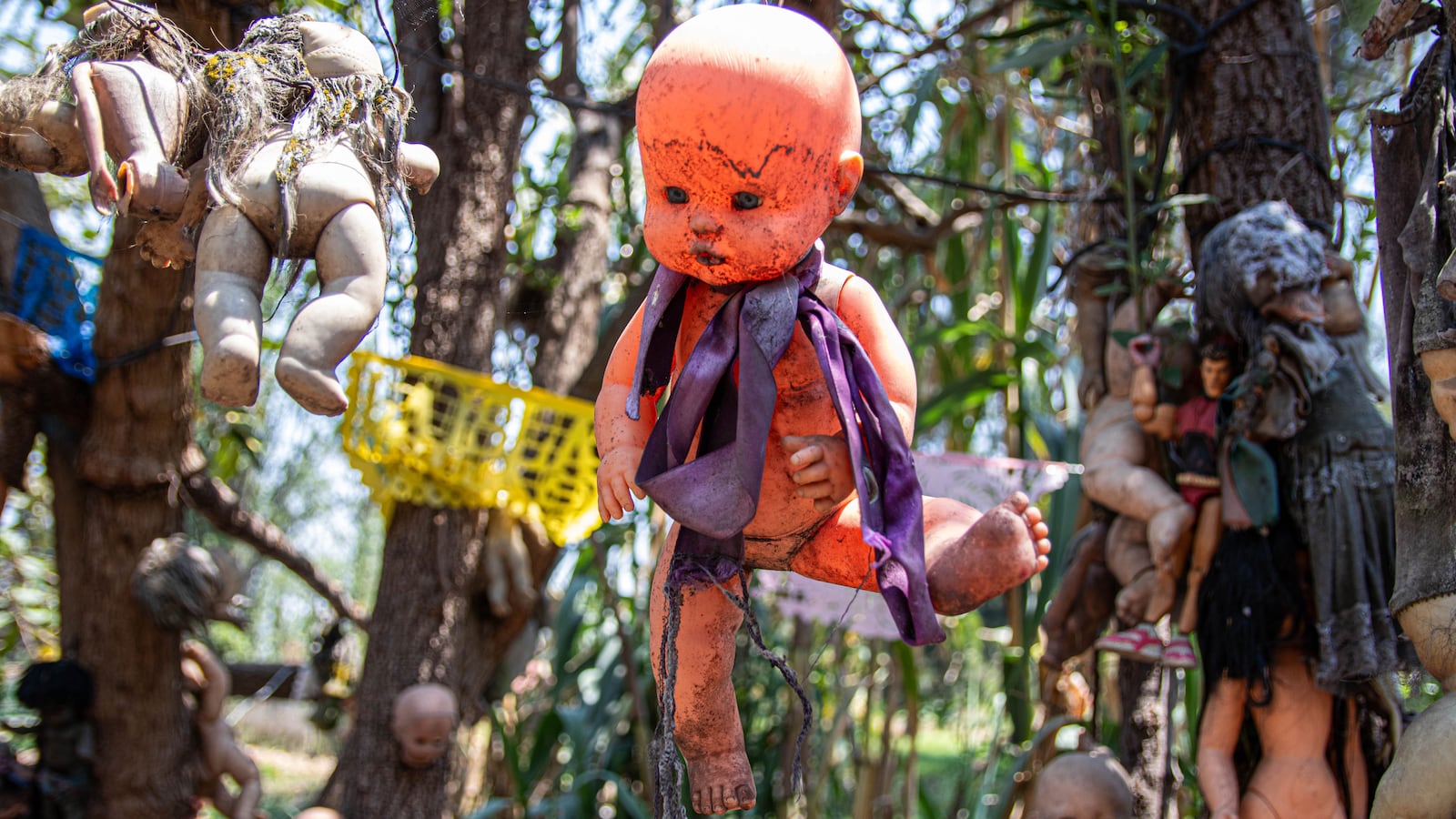Even on the brightest days, a dark pall hangs over La Isla de las Muñecas, the Island of the Dolls. The name sounds cutesy and sweet, but the reality couldn’t be more different.
Tucked away deep in the lush canal system of Xochimilco on the southern outskirts of Mexico City, accessible only by colorful flat bottomed gondola-style trajineras, the small island is dotted with a few trees and a handful of ramshackle huts with clothes lines crisscrossing the air. Everywhere you look there are approximately 1,500 dolls, exposed to the elements without protection or maintenance, each one more horrifying than the next.
The haunting collection of toy orphans are dirty, decomposing, and misshapen with heat blistered skin, bulging stomachs, missing eyes, ripped off appendages, and ragged hair. Walking amongst them makes you feel like you’re experiencing a waking nightmare in which they reanimate, like infantile zombies, to devour you with their grimy plastic mouths. If they ever make another Child’s Play movie, they should film it on the Island of the Dolls.

According to our guide, Leo Rivera, who has been taking tours to the island for nearly a decade, the island’s origins are as murky as the canal waters surrounding it. In the early 1950s, Don Julian Santana (sometimes known with the additional last name of Barrera) saw an 11-year-old girl drown by the island; perhaps she had a doll with her. Some say he tried to save her. Others say she was dead when he found her. Others still say he imagined the entire episode, because there is no official record of a girl drowning or a body being recovered.
No matter the specifics, the story birthed an obsession. Don Julian began collecting dolls to either appease or honor the spirit of the little girl, and perhaps ward off any other evil spirits lurking nearby. Over the next five decades, he began displaying the dolls with chaotic abandon. As the collection grew, the island became an oddball “dark tourism” attraction for those willing to venture deep into Xochimilco.
In 2001, tragedy once again struck the island in a bizarre redux. Don Julian was discovered drowned in the same spot in the canal where the body of the little girl was supposedly found.
Since then, the island’s management has been taken over by Don Julian’s descendants. On the day I visited this past March with my wife and our 10-year-old son, Rogelio Sanchez Santana was on hand to collect small fees for us to access the island and take pictures. Dressed in an impossibly white long-sleeve performance shirt and dapper blue and white shorts, Rogelio sported a navy blue vest emblazoned with the island’s logo, an array of silver necklaces, Pit Viper style sunglasses, and a black San Francisco Giants baseball hat. A cigarette was lodged behind his left ear.
Disembarking from the boat, we were immediately surrounded by dolls—nailed to buildings, lodged into tree notches, dangling from clotheslines, and roped to fences. I’m reminded of what Rivera told us as we were booking the expedition. “It’s not for everyone,” he said. “It’s for people with an open mind. You don’t have to believe in the spirits, but you do have to respect the culture and what other people believe.”'

I hoped my wife and son were remembering his guidance. We had all been intrigued by the island as a day trip, but now that we were there, I could tell they were having second thoughts. Not that I wasn’t. Las Isla de las Muñecas was creepy as hell—even when you’re respecting what other people believe.
Under the advice of our guide, we arrived with a stuffed bear as an offering to the spirits of the island.
“Don’t worry,” Rivera assured me when I expressed concern we weren’t bringing an actual doll. “You just want to bring something that would appeal to an 11-year-old girl.”
Santana initially wouldn’t take the bear. Instead, he ushered us out of the blazing sun into a shed that afforded some welcome shade, though I could tell my wife and son didn’t consider it the best tradeoff. Dozens of dolls were on the walls, hung from the rafters, or simply propped up on the ground. A few jars held doll parts suspended in green liquid, as if they were being preserved in formaldehyde. There was a wooden shrine shaped like one of the trajinera boats that was overflowing with dolls and other offerings—an unopened bottle of Corona, handmade bead bracelets, coins, cigarettes, candles, and a vase of dying, yellow-tinged lilies. Above this madcap altar was a faded photo of Don Julian, the broad smile spreading out underneath his mustache offset by eyes as black as midnight.

Santana gestured for the bear. My son handed it to him, a hostage smile plastered on their face as they gave me a “Dad, what the hell have you gotten us into?” look. Per tradition, Santana performed a crude baptism on the teddy by muttering some incantation while waving a staff topped off with the head of a doll, its empty sockets ringed with black as if its eyes were consumed by fire. Our offering was so incongruous, its clean brown fur, hopeful smile, and dapper plaid vest standing out against the dust and decay consuming the other dolls. I felt bad we were leaving the bear, but traditions must be maintained, spirits must be honored, and bad juju needed to be kept away.
After the ceremony was done, we were ushered back outside and told we could stay as long as we liked during the day (it is possible to spend the night for an additional fee, but you couldn’t have paid my family to be there after nightfall). We began exploring the island itself, which began as a chinampas, a floating garden built in the pre-Hispanic period to boost agricultural production when this region was Lake Xochimilco. A raft made of juniper branches would be piled high with mud and soil, planted with crops, and tied to juniper trees on the shore. When the raft sank, a new one was built above it, eventually forming the basis for an island. As more of these islands formed, the lake was reduced to a canal system, now spanning 110 miles. In 1987, Xochimilco was named a UNESCO World Heritage Site.
It took less than an hour to fully explore the island and its unsettling inhabitants. No matter how many we saw, the sight never became normalized for me.

“This place is just weird,” my wife said as she resignedly posed for a photo in front of a dead shrub covered in dirty dolls that could have been a serial killer’s Christmas tree. “Let’s get out of here.”
I didn’t disagree on either point. Soon enough, we were back in the trajinera to make the two-hour trip to our departure point at Nuevo Nativitas Embarcadero, which would be followed by an hour-long drive to our hotel in the city’s Roma neighborhood.
As our boat slipped through the mucky green waters of the canal, I looked back and shivered a little, despite the blistering heat of the day. No matter the truth of the island’s legend, there was no doubt its beyond-freaky doll collection would be living rent-free in my mind for the rest of my life, skulking in the void, just waiting to inspire nightmares.

